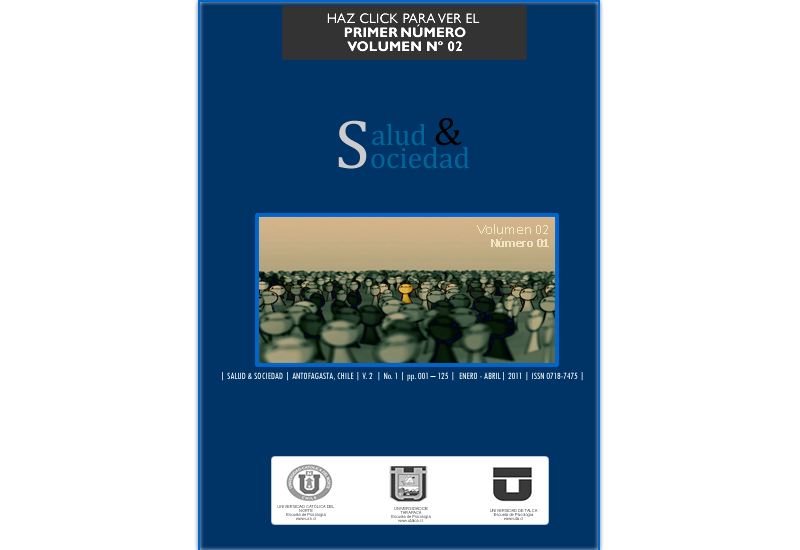Factores asociados a la sintomatología depresiva en adultos/as con diabetes y el impacto en su autoeficacia y en el cuidado de la salud
DOI:
https://doi.org/10.22199/S07187475.2011.0001.00003Palabras clave:
Depresión, Autocuidado, Autoeficacia, Diabetes, depression, self-care, self-efficacy,Resumen
El objetivo principal del estudio fue crear un modelo para explicar la sintomatología depresiva de pacientes diabéticos/as, su nivel de autoeficacia, y las prácticas de autocuidado para manejar la condición. Se examinó cómo la diabetes y las variables sociodemográficas, podrían estar asociadas a la depresión. A su vez, se evaluó si estas variables influían sobre la autoeficacia y las prácticas de autocuidado. Participaron 267 pacientes diabéticos/as, de los cuales 68 cumplieron con sintomatología depresiva y 199 que no la presentaron. Se utilizaron instrumentos de auto-reporte para medir las variables. Los resultados sugirieron que los/as pacientes no casados/as, cuyos síntomas de diabetes eran más severos y que presentaban un mayor impedimento en la funcionalidad debido a la diabetes, tenían más probabilidades de presentar una cantidad mayor de síntomas depresivos. Por su parte, los/as pacientes de mayor edad y cuyos síntomas de diabetes eran más severos, mostraron mejores prácticas de autocuidado. En cuanto a la autoeficacia, los/as pacientes cuyos síntomas de diabetes eran más severos y cuyo impedimento en funcionalidad era peor, mostraron más probabilidades de presentar una autoeficacia baja para lidiar con su condición. Los resultados tienen implicaciones significativas en términos de prevención, identificación y tratamiento para la depresión en adultos/as puertorriqueños/as con diabetes.
The main objective of the study was to create a model to explain the depressive symptomatology in diabetic patients, their self-efficacy and self-care practices to manage the condition. It examines how diabetes and its socio demographic variables may be associated with depression. It also evaluates if these variables influences self-efficacy and self care practices of the patients. Participants consisted of 267 diabetic patients of which 68 met the criteria for depressive symptoms and 199 participants did not meet the criteria. Self-reporting instruments were used to measure variables. The results suggested that participants that are not married and whose diabetic symptoms were more severe have a higher probability of presenting a higher quantity of depressive symptoms. On the other hand, patients in the higher age group and whose diabetic symptoms were more severe showed better self care practices. In terms of self-efficacy, patients whose diabetic symptoms were more severe and whose functional impairments were greater showed a higher probability of presenting low self-efficacy in terms of dealing with their condition. Results have significant implications in terms of prevention, identification, and treatment of depression in Puerto Rican adults with diabetes. We will discuss the implications, limitations of our results, and recommendations.
Descargas
Referencias
Ali, S., Stone, M.A., Peters, J. L., Davies, M. J., & Khunti, K. (2007). The prevalence of comorbid depression in adults with type 2 diabetes: A systematic review and metaanalysis. Diabetes Medicine, 23, 1165-1173.
Cherrington, A., Wallston, K. A., & Rothman, R. L. (2010). Exploring the relationship between diabetes self-efficacy, depressive symptoms, and glycemic control among men and women with type 2 diabetes, Journal of Behavioral Medicine, 33, 81-89.
Ciechanowski, P., Katon, W.J., Russo, J.E., & Hirsch, I.B. (2003). The relationship of depressive symptoms to symptom reporting, self-care and glucose control in diabetes. General Hospital Psychiatry, 25, 246-252.
Corson, K., Gerrity, M., & Dobscha, S.K. (2004). Screening for depression and suicidality in a VA primary care setting: 2 items are
better than 1 item. The American Journal of Managed Care, 10, 839-1292.
Dall, T. M., Mann, S. E., Zhang, Y., Quick, W. W., Seifert, R. F., Martin, J., Huang E. A., Zhang, S. (2009). Distinguishing the economic costs associated with type 1 and type 2 diabetes. Population Health Management, 12, 103-110.
Daly, M (2010). Diabetes and depression. Tai Kiati Nursing New Zealand, 16, 14-16.
De Groot, M., Anderson, R., Freedland, K.E., Clouse, R.E., & Lustman, P.J. (2001). Association of depression and diabetes complications: A meta-analysis. Psychosomatic Medicine, 63, 619-630.
Derogatis, L.R., Lipman, R.S., Rickels, K. Uhlenhuth, E.H., & Covi, L. (1974a). The Hopkins Symptom Checklist (HSCL): A measure of primary symptom dimensions. Modern Problem Pharmacopsychiatry, 7,
79-110.
Derogatis, L.R., Lipman, R.S., Rickels, K. Uhlenhuth, E.H., & Covi, L. (1974b). The Hopkins Symptom Checklist (HSCL): A self report symptom inventory. Behavioral Science, 19, 1-15.
Diez-Quevedo, C., Rangil, T., Sánchez-Planell, L. Kroenke, K., & Spitzer, R. (2001). Validation and utility of the patient health
questionnaire in diagnosing mental disorders in 1003 general hospital Spanish inpatients. Psychosomatic Medicine, 63, 679-686.
Egede, L.E., Zheng, D., & Simpson, K. (2002). Comorbid depression is associated with increased health care use and expenditures in individuals with diabetes. Diabetes Care, 25, 464-470.
Fortmann, A. L., Gallo, L. C., Walker, C., & Philis-Tsimikas, A. (2010). Support for disease management, depression, selfcare, and clinical indicators among Hispanics with type 2 diabates in San Diego County, United Sates of America. Revista Panameña de Salud Pública, 28, 230-234.
Fraenkel, J. & Wallen, N. (2003). How to design and evaluate research in education (5th ed.). New York: McGraw Hill.
Harrar, S. (2004). Prevention’s the sugar solution. Emmaus, PA: Rodale Inc. IDF Clinical Guidelines Task Force. (2005). Global guideline for Type 2 diabetes. Brussels: International Diabetes Federation.
Jacobson, A. M., De Groot, M., & Samson, J. A. (1997). The effects of psychiatric disorders and symptoms on quality of life in patients with type I and type II diabetes mellitus. Quality of Life Research, 6, 11-20.
Katon, W. J., Lin, E. H., Russo, J., Von Korff, M., Ciechanowski, P., Simon, G., Ludman, E., Bush, T., & Young, B. (2004). Cardiac risk
factors in patients with diabetes mellitus and major depression. Journal of General Internal Medicine, 19, 1192-1199.
Katon, W. J., Rutter, C., Simon, G., Lin, E., Ludman, E., Ciechanowski, P., Kinder, L., Young, B., & Von Korff, M. (2005). The association of comorbid depression with mortality in patients with type II. Diabetes
Care, 28, 2668-2672.
Kerlinger, F. & Lee, H. (2002). Investigación del comportamiento: Métodos de investigación en ciencias sociales (4ta ed.). México:
McGraw Hill/ Interamericana.
Kraaij, V. & de Wilde, E.J. (2001). Negative life events and depressive symptoms in the elderly: A life span perspective. Aging and Mental Health, 51, 84-92.
Lauren, C., Brown, S., Majumdar, R., Stephen, C., & Johnson, J. (2005). History of depression increases risk of type 2 diabetes in younger adults. Diabetes Care, 28, 1063-1067.
Lloyd, C. (2008). Los efectos de la diabetes sobre la depresión y de la depresión sobre la diabetes. Diabetes Voice, 53, 23-26.
Lin, E., Katon, W., Von Korff, M., Rutter, C., Simon, G. E., Oliver, M., Ciechanowski, P., Ludman, E. J., Bush, T., & Young, B. (2004). Relationship of depression and diabetes self-care, medication adherence, and preventive care. Diabetes Care, 27, 2154-2160.
Lustman, P. J., Anderson, R. J., Freedland, K. E., Groot, M., Carney, R. M., & Clouse, R.E. (2000). Depression and poor glycemic control: A meta-analytic review of the literature. Diabetes Care, 23, 934–942.
Machado-Romero, A., Anarte-Ortiz, M. T., Navas, S. R. (2010). Predictores de calidad de vida en pacientes con diabetes mellitus
tipo 1. Clínica y Salud, 21, 35-47.
McClendon, J. (1996). Effect of treatment for depression on diabetes self-efficacy. Disertación doctoral publicada, Universidad de Colorado, Centro de Ciencias de la Salud, Colorado, Estados Unidos.
Mier, N., Bocanegra-Alonso, A., Zhan, D., Wang, S., Stoltz, S. M., & AcostaGonzález, R. I. (2008). Clinical depressive symptoms and diabetes in a binational boder population. Journal of the Board of
Family Medicine, 21, 223-233.
Moussavi, S., Chatterji, S., Verdes, E., Tandon, A., Patel, V., Ustun, B. (2007). Depression, chronic diseases, and decrements in health: Results from the World Health Surveys. The Lancet, 370, 851-858.
Nunally, J.C. (1995). Teoría psicométrica (3era ed.). México: McGraw Hill. Petrak, F., Hautzinger, M., Plack, K., Kronfeld, K., Ruckes, C., Herpertz, S., & Müller, M. J. (2010). Cognitive behavioural therapy in elderly type 2 diabetes patients with major depression. BMC Geriatrics, 10, 1-9.
Raval, A., Dhanaraj, E., Bhansali, A., Grover, S., & Tiwari, P. (2010). Prevalence and determinants of depression in type 2 diabetes patients in a tertiary care center. Indian Journal of Medical Research, 132, 195-200.
Schwarzer R. & Fuchs, R. (1995). Self-efficacy and health behavior. En M. Corner & P. Norman, Predicting health behavior (pp. 163-196). New York: Freeman.
Spencer, M. S., Kieffer, E. C., Sinco, B. R., Palmisano, G., Guzmán, J. R., & James, S. A. (2006). Diabetes-specific emotional distress among type 2 diabates. Journal of Health Care, 17, 88-105.
Spitzer, R. L., Kroenke, K. & Williams, J. B. (1999). Validation and utility of a self-report version of PRIME-MD: The PHQ primary care study. JAMA, 282, 1737-1744.
Spitzer, R. L., Williams, J. B., & Kroenke, K. (2003). The Patient Health Questionnaire- 2: Validity of a two-item depression screener. Medical Care, 41, 1284-1292.
Talbot, F., Nouwen, A., Gingras, J., Gosselin, M., & Audet, J. (1997). The assessment of diabetes-related cognitive and social factors: The Multidimensional Diabetes Questionnaire. Journal of Behavioral Medicine, 20, 291-312.
Toobert, D. J. & Glasgow, R. E. (1994). Assessing diabetes self-management: The Summary of Diabetes Self-care Activities questionnaire. En Bradley C, Handbook of Psychology and Diabetes (pp. 351–375). Switzerland: Harwood Academic.
Toobert, D. J., Hampson, S. H., & Glasgow, R. E. (2000). The Summary of Diabetes Selfcare Activities measure: Results from 7 studies and revised scale. Diabetes Care, 23, 943-950.
Tweedy, K., Morrison, M., & Gelbach, S. (2002). Depression in older women. Psychiatric Annals, 32, 417-430.
Vinaccia, S., Fernández, H., Escobar, O., Calle, E., Andrade, I. C., Contreras, F., Tobón, S. (2006). Calidad de vida y conducta de
enfermedades en pacientes con diabetes mellitus tipo II. Suma Psicológica, 13, 15-31.
Whitty, P., Steen, N., Eccles, M., McColl, E., Hewison, J., Meadows, K., Clapp, Z., & Hutchinson, A. (1997). A new selfcompletion outcome measure for diabetes: Is it responsive to change? Quality of Life
Research, 6, 407–413.
Winkley, K. (2008). The epidemiology of depression in diabetes. European Diabetic Nursing, 5, 91-96.
World Federation for Mental Health. (2010). Diabetes and depression: Why treating depression and maintaining positive mental health matters when you have diabetes. Virginia: World Federation for Mental Health.
Wulsin, L., Somoza, E., & Heck, J. (2002). The feasibility of using the Spanish PHQ-9 to screen for depression in primary care in Honduras. Primary Care Companion Journal of Clinical Psychiatry, 4(5), 191- 195.
Zhang, X., Norris, S., Gregg, E., & Cheng, Y. (2005). Depressive symptoms and mortality among persons with and without diabetes. American Journal of Epidemiology, 161, 652.
Descargas
Publicado
Número
Sección
Licencia
Los autores continúan como propietarios de sus trabajos, y pueden volver a publicar sus artículos en otro medio sin tener que solicitar autorización, siempre y cuando indiquen que el trabajo fue publicado originariamente en Revista Salud & Sociedad (ISSNe:0718-7475).



_(1).png)





